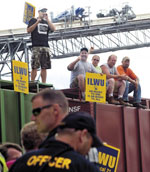
Showdown on West Coast Docks: The Battle of Longview
(November 2011).
click on photo for article

Chicago Plant Occupation Electrifies Labor
(December 2008).
click on photo for article
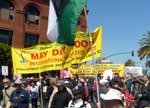
May Day Strike Against the War Shuts Down
U.S. West Coast Ports
(May 2008)
click on photo for article

April 2022
Democrats, NLRB No Friends of Labor
Amazon Labor Union Victory at JFK8
Organize All of Amazon with Class
Struggle!
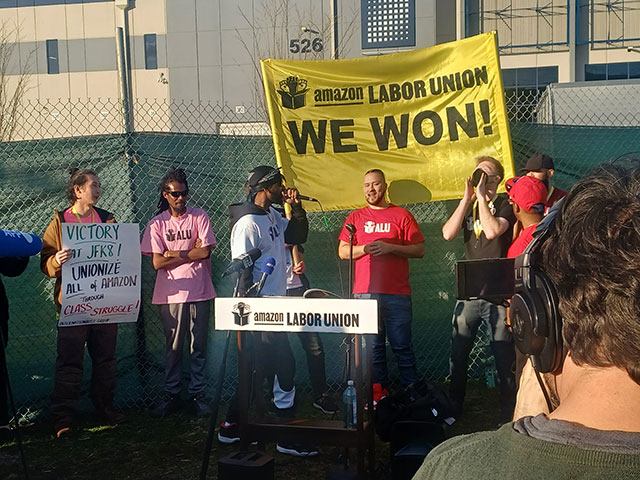
Worker activists of the Amazon Labor Union hold press conference at the JFK8 warehouse in Staten Island, New York, April 8, a week after the ALU’s decisive victory in union representation election. (Internationalist photo)
On Friday, April 1, the Amazon Labor Union (ALU) won a historic vote to unionize the massive JFK8 warehouse on Staten Island, New York, by a vote of 2,654 to 2,131. This is the first union victory in North America against the giant distribution and e-commerce monopoly, which has 1.1 million employees in the U.S alone. The vote, which the New York Times (1 April) called “one of the biggest victories for organized labor in a generation,” came amid growing restiveness in the working class, and followed large strikes last fall at John Deere, Nabisco, Kellogg’s, and elsewhere. It will be a beacon for millions of workers at Amazon and throughout country who desperately need unionization to fight against the low wages, miserable “benefits” and deadly working conditions that are the standard in capitalist America. As Internationalist Group placards declared at victory celebrations after the vote: Victory at JFK8! Organize All of Amazon with Class Struggle!
The next stage of the battle will be to get the viciously anti-union Amazon bosses to negotiate and sign a contract. The union has issued a statement demanding that collective bargaining begin in early May. But even in Europe, where Amazon workers have been represented by unions in several countries for many years, in only one location, in Italy, have the workers been able to force the giant company to sign a contract – through a strike. After the victory at JFK8 was announced, on April 8 Amazon filed 25 objections with the National Relations Board (NLRB) contesting the election, scurrilously claiming that the union “intimidated” workers and that the NLRB – a capitalist body – unfairly influenced workers to vote for the union! Amazon will seek to avoid recognizing and bargaining with the ALU by tying it up in the capitalist courts and the NLRB, whose fundamental purpose is to control and suppress workers’ struggles.
It has now been reported that Amazon is planning to set up an employee app in which workers could message each other to cheer on fellow workers to more productivity, while banning words like “union,” “plantation,” “slave labor,” “grievance,” “living wage,” “robot” and “restroom,” among many others. (“Restroom” is banned because Amazon workers, typically treated worse than Amazon’s robots, often are not given time to go to the bathroom.) Working for Amazon is so dystopian it makes Boots Riley’s 2018 anti-capitalist movie “Sorry to Bother You,” with its slave-labor company WorryFree, seem like social realism rather than fantasy.
Also on April 1, initial results were announced from a mail-in vote to determine if the RWDSU (Retail, Wholesale and Department Store Union) would represent workers at Amazon’s BHM1 warehouse in Bessemer, Alabama. Votes against the union were in the lead by 993 to 885, but with 416 contested ballots the election is too close to call. While the union is unlikely to win, the result is much closer than the first vote at Bessemer a year earlier, when the company won by more than a two-to-one margin. That first election was declared void by the NLRB based on Amazon’s brazen and pervasive efforts to intimidate workers even beyond what the government’s “labor laws” typically allow.
Staten Island Win Follows Bessemer Setbacks
Last year, the Internationalist Group traveled to Bessemer repeatedly during the unionization drive (see our article, “Amazon Union Drive in Alabama Electrifies Labor,” The Internationalist No. 62, January-March 2021). This year, an Internationalist team attended a February 26 union solidarity rally in Bessemer, where we talked with union activists who had come from around the South, and with some of the worker-activists who have been organizing inside BHM1. There was a contingent of miners from the Warrior Met coal strike, now over a year old, in nearby Tuscaloosa County; that strike has been ground down centrally by the UMWA bureaucrats’ refusal to build mass picket lines that would stop the scabs and shut down production. The capitalist courts of course issued injunctions against picketing, but every class-struggle militant knows that you can’t play by the bosses’ rules and expect to win.
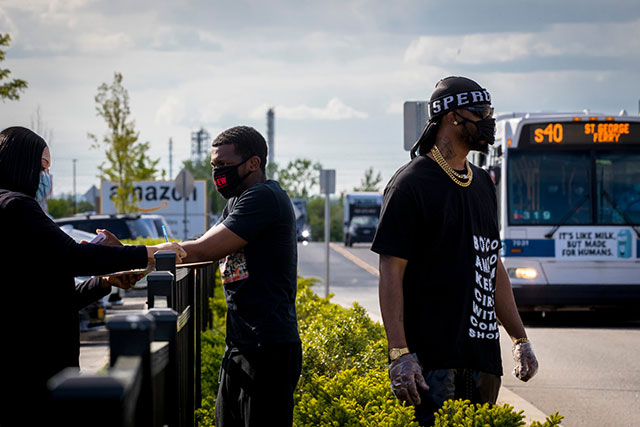
Amazon Labor Union leaders Derrick Palmer (left) and Chris Smalls outside Staten Island JFK8 warehouse, May 2021. (Photo: Dave Sanders for the New York Times)
After the RWDSU’s loss last spring in Bessemer, many commentators weighed in on why the union lost. Now many are commenting on how and why the Amazon Labor Union won in Staten Island, an outcome unexpected by many. The ALU announced its campaign only eleven months ago, soon after the April 2021 defeat in Bessemer. The ALU was initiated by Chris Smalls, a former supervisor at JFK8 who had been fired in March of 2020 after leading a protest against the lack of COVID safety protocols in the warehouse. When Smalls, along with a few workers in the warehouse, launched the unionization campaign, they said that it would be different than Bessemer because the ALU was “worker-led” and independent of the traditional unions. Amazon immediately responded with an anti-union campaign, spending millions to fly in highly paid “union-prevention” consultants. The racist Amazon bosses smeared the mostly black ALU activists as “thugs,” erected fences in an attempt to drive them away from the warehouse, and fired at least one union activist.
The ALU over time expanded its core of worker-organizers and gathered some 2,500 election authorization cards in six months. An initial attempt to file for an election for four warehouses on Staten Island with more than 10,000 workers was withdrawn by the union in October as the NLRB indicated that half the cards were of workers who had already quit or been terminated by Amazon. Gathering more cards and restricting the filing to the JFK8 warehouse and the LDJ5 sortation center, the ALU re-filed on December 22. This time the NLRB accepted the cards as sufficient and approved holding the election at JFK8 and also one at LDJ5, where the election will be held at the end of April. Right now, ALU organizers are fighting against an intense anti-union barrage by the Amazon bosses at LDJ5.
As Chris Smalls and others have noted, it is almost impossible to get 30% of currently employed workers (as required under NLRB rules) to sign cards at an Amazon warehouse, because of the company’s staggering worker turnover rate of 150% a year, almost double the logistics industry average. This means that workers only stay at Amazon for nine months on average. The rapid turnover of workers is a deliberate policy of Amazon not only to prevent the cohering of a pro-union workforce, but also to ruthlessly squeeze the workers for productivity and pace, maximizing the rate of exploitation, and then discarding the workers.
Amazon’s production methods thus notoriously produce a “surplus” of injured and dead workers. (Its injury rate is 80% above the “normal” rate of capitalist maiming in this industry (see our front-page article, “Unionize Amazon with Class Struggle!” in The Internationalist No. 65, October-December 2021). Just last December 10, six Amazon workers were killed in Edwardsville, Illinois when tornadoes struck a flimsily built company warehouse. Workers were not provided proper shelter and not allowed to leave. Amazon’s business model has relied on a pool of millions of workers willing to take its conditions of employment, with pay and benefits above the legal minimum but far below an actual “living wage.” Amazon’s model ran into trouble with the pandemic-related “labor shortage.” And its $18.25 per hour wage at JFK8 is worth little in New York City, where the cost of living is more than 50% higher than in Alabama.
The ALU refers to itself as a “worker-led” union. In countering the company’s anti-union propaganda barrage, part of its greater success than the RWDSU has had in Alabama was that it was hard for Amazon to put over its lie that unions are a “third party” of “outsiders.” In the final push, ALU activists at JFK8 (including an Internationalist Group supporter) carried out intensive phone banking and “occupied” break rooms to talk to workers and distribute union literature. Union activists sought out and won over respected workers and intervened to counter the anti-union propaganda in the company’s mandatory “captive audience” meetings. Also, a week before the election, the union issued a list of eight “immediate demands” that would improve pay and working conditions. The UNITE HERE union and the United Food and Commercial Workers (UFCW) provided office space and assisted in the campaign’s final get-out-the-vote push.
Yet in significant ways, the ALU campaign was not very different than “traditional” union organizing campaigns. It looked to the present government-regulated system of “labor relations” for support, including a heavy orientation to and reliance on NLRB election rules, rather than basing itself on a mobilization of workers’ power independently of the capitalist state and its parties. The ALU correctly filed regular complaints with the NLRB against Amazon’s violations of labor laws. In the past, under both Democratic and Republican administrations, complaints about companies’ gross violations of workers’ rights often went nowhere. But the violations at JFK8, along with findings at other Amazon warehouses, resulted in a national settlement between Amazon and the NLRB in December under which Amazon agreed to post notice to all its employees that the company would agree to abide by labor laws that allow union activists to talk to workers in non-work areas during non-work times.
Contrary to some reports, the ALU did not engage in “wildcat strikes,” and did not call for large rallies of JFK8 workers at the warehouse as a show of strength, as our supporter had advocated. Like the RWDSU in Alabama, while promoting statements of support by celebrities, the ALU also sought the usual grandstanding photo ops by Democratic politicians, such as New York City Public Advocate Jumaane Williams and Congresswoman Alexandria Ocasio-Cortez (a no-show for an ALU rally). The ALU leadership lauded New York State attorney general Leticia James, who in November 2021 sought a monitor to see that Amazon would abide by COVID-19 safety protocols (after beginning an investigation over a year earlier). Following the victory at JFK8, Senator Bernie Sanders praised the ALU for launching a “national, sweeping movement,” while Democratic president Joe Biden declared “Amazon, here we come.” Yet between these capitalist Democratic politicians currently running the federal government (as well as many cities and states) and Amazon workers toiling on Jeff Bezos’ plantation, there is no “we.”
New Showdown Coming Up Soon
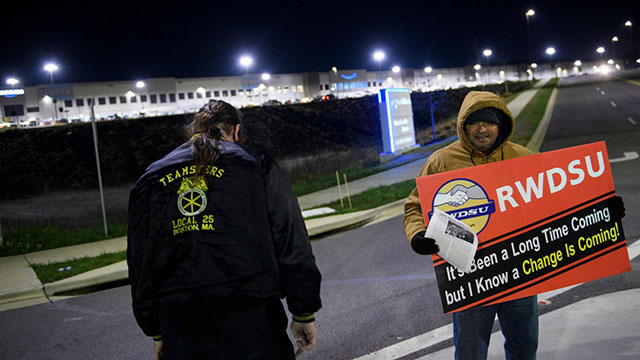
Mobilize labor's power to unionize Amazon! Class-struggle trade-unionists in Boston Teamsters Local 25 (above), Portland Painters Local 10, Los Angeles Transit Workers Local 1277 and New York airport workers traveled to Bessemer, Alabama repeatedly during 2021 in solidarity with union organizing drive at Amazon there. (Photo: Patrick Fallon / AFP)
In the aftermath of its victory, the ALU says it has received emails and texts from workers at some 100 Amazon facilities asking for help or advice on how to organize. ALU leaders Chris Smalls and Derrick Palmer traveled to Washington to meet with the International Brotherhood of Teamsters (IBT), which last year announced a national campaign to organize Amazon warehouse workers and drivers, on how to proceed with organizing Amazon. Sean O’Brien, the new head of the Teamsters, pledged to intensify efforts to organize Amazon after the ALU victory, while Liz Shuler, the new head of the AFL-CIO, has pledged to support the Teamster campaign. It sounds good, but worker-activists and organizers should be under no illusion that playing by NLRB rules will be sufficient for a mass organizing campaign, nor even for winning a contract on Staten Island.
Building on the ALU’s win in the union recognition election, what will it take to defeat labor-hater Jeff Bezos – off and on the richest man in the world – in the looming battles? As we wrote in December, in “Unionize Amazon with Class Struggle” (Internationalist No. 65):
“To unionize Amazon, it will be necessary to mobilize the power of the workers movement in sharp class struggle. The normal tactics of ‘business unionism,’ based on collaboration with management, won’t cut it. To defeat the hard-nosed union-busters at Amazon will take strikes and walkouts, flying pickets, plant occupations – the kind of class-struggle methods that built the unions in the 1930s. Unionization must include everyone from pickers and drivers to airline pilots, nationally, and internationally. And it requires independence from the bosses’ government and parties, as we fight to build a class-struggle workers party that defends black people, women, immigrants and all the oppressed.”
This perspective is counterposed to the trade-union bureaucracy’s decades-long support to U.S. imperialism’s Democratic Party, which has received big bucks from Amazon management (as well as from other Wall Street and Big Tech bosses). Often posing as “friends of labor” to garner votes, at every turn of serious class struggle a Democratic mayor, governor or president will call out their police and National Guard to repress workers, as did Franklin D. Roosevelt, who is supposed to have given workers the “right to organize.” (In fact, FDR was trying to control militant labor struggles, including sit-down strikes and general strikes, which are what actually established the mass industrial unions.) It is the trade union tops’ obedience to the bourgeois labor laws and court injunctions, and their political “partnership” with the bosses and their parties, that has led to the decimation of the labor movement over the past several decades.
Illusions in the capitalist Democrats are also spread by reformist groups, some of which have worked hard in supporting the Amazon unionization drive in Staten Island, notably the Communist Party (CPUSA) and its youth group, the YCL, as well as Workers World Party (WWP) and its Workers Assembly Against Racism (WWP/WAAR). Despite its name, the CP has supported the Democrats in every election for decades. WWP/WAAR, for its part, absurdly calls on Democratic president Biden to “issue an executive order to implement the PRO Act” (a bill to reform the NLRB, rather than fighting to get rid of capitalist state regulation of unions) and appeals to Jeff Bezos – Amazon’s founder, pandemic profiteer and chief space cadet – to just “recognize the union and negotiate now!” Such appeals for class collaboration are counterposed to the hard class struggle it will take to win.
The first-ever victorious union-recognition vote at an Amazon warehouse in North America has sent shock waves around the country and internationally. The vote for the ALU could spark a broad unionizing effort at Amazon and beyond, and energize labor struggles generally. Yet among mainline labor bureaucrats – notoriously unsuccessful in unionizing Amazon, Walmart, fast food and other low-wage industries – the conclusion of some is to do even less, to let the newbies do the hard work and throw them some change and pro bono hours from union lawyers. Mainstream media highlight the ALU’s use of TikTok videos, while Amazon complains about the union’s offer of free weed. In reality, a major factor, as the ALU’s Chris Smalls pointed out, is that New York City is still a union town. But crucial to the outcome in Staten Island was not one or another gimmick or new tactic but the hard work of connecting with workers day in and day out (see our interview with an ALU activist at JFK8). And it is only the first step.
The key to winning the major class battle at Amazon, as well as to organizing the unorganized and building a fighting labor movement overall, will be to forge a solid core of class-struggle militants in the warehouses, factories and other workplaces. This is vital to building a fighting leadership capable of waging and winning the big battles ahead. They must explain to the ranks that it was reds that built the industrial unions, and it will take genuinely revolutionary political struggle to break the stranglehold of capitalist Democrats and pro-capitalist labor bureaucrats that has been driving the unions to the grave. Amazon, with its brutally “efficient” methods of squeezing every last drop of blood out of its “associates,” is a glaring example of the whole system of exploitation that makes the wheels of capitalism turn. The struggle to unionize Amazon highlights the urgency of building a workers party to fight for a workers government. Because only through socialist revolution can we put an end to the capitalist system of exploitation, racist oppression and war. ■
Interview with ALU Worker at Staten Island Amazon Warehouse
Unionizing
Amazon Will Be
a Huge Class Battle
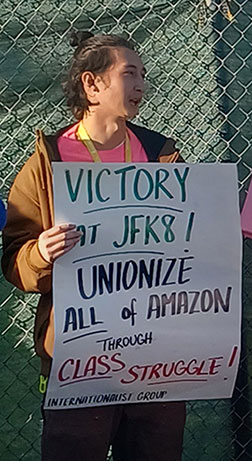 Amazon Labor Union
worker-activist Will at ALU press conference outside
JFK8 warehouse in Staten Island, New York, April 8.
(Internationalist
photo)
Amazon Labor Union
worker-activist Will at ALU press conference outside
JFK8 warehouse in Staten Island, New York, April 8.
(Internationalist
photo)The Internationalist interviewed Will, a supporter of the Internationalist Group who works at Amazon’s big warehouse in Staten Island, New York and has been part of the Amazon Labor Union effort almost from the start.
Internationalist: Tell us a little about your work, and what things are like at the warehouse.
Will: I work at the JFK8 Fulfillment Center, I’ve worked there for about a year now, and I am a packer, which means I put items into boxes. Working conditions are pretty grueling. My shifts are 12 ½ hours long, plus I have at least a two-hour commute going to and coming from work. That’s very common for the workers there.
We are expected to keep up our “rate,” which is the speed at which we complete our tasks. That is often very difficult physically. We get three breaks – two 15-minute breaks, one 45-minute unpaid lunch break. That’s way too little. The two 15-minute breaks used to be 20 minutes during the pandemic, but then they reduced it back to “normal.” That made a lot of workers angry. The union is demanding a restoration of 20-minute breaks.
Internationalist: Can you tell us a little about the union and the campaign?
Will: I started working with the union in April or May of 2021, right after the campaign began. The first task that I volunteered to do was to convince my coworkers to sign union authorization cards, which was the main thing we were doing before the election was authorized. Sometimes in the warehouse during breaks, sometimes at the ALU table out near the bus stop. After we got the election authorized in December, I also did some “phone banking,” calling coworkers to try to convince them to vote yes for the union and answer any questions that they had.
Internationalist: What were some of their questions?
Will: A lot were basic ones, about what is a union, why would they want a union. So I would answer that that a union is a collective body of workers fighting to win better conditions. Without a union, when the company wants to discipline us or fire us we stand alone against a huge corporation. With a union, instead of a single worker against the entire Amazon company, it would be the collective of workers against the company. And as an organized group, we would also fight to improve working conditions: longer breaks, more PTO [paid time off], higher pay, better benefits and ending the system of counting every “unproductive” minute we’re on the job, what Amazon calls TOT. That’s “time off task,” and workers hate it.
Internationalist: I think our readers would be interested in what other concrete things the union did, especially since the ALU’s victory in the election was the first time ever in North America.
Will: I think what was key was the work inside the warehouse. In the month and week preceding vote, the ALU “occupied” the break room. We had a table there, distributing food and leaflets and talking to workers, convincing them to vote for the union, telling them what a union can do. I’m on the overnight shift, where there wasn’t as much union activity. I suggested that workers on the weekend overnight shift keep the table up and I helped tabling during my breaks. It went well, we distributed union literature and talked to quite a few workers. One night I and a co-worker talked to maybe 75 people during the breaks, and we “flipped” a decent amount. In other words, won over workers who had been skeptical about the union.
Many of the union rallies were in Manhattan and Brooklyn. From early on, I suggested that we hold a union recognition rally at shift change at the warehouse. I thought that would be a good way to get workers to see the strength of the union and participate in union activity, to have a show of force so that other workers could see that there were many of us in support of the union and that they shouldn’t be afraid of being vocal in support of it. Also that we should raise some specific demands, like for a big pay hike and longer breaks.
Internationalist: How did Amazon try to fight the union?
Will: As soon as the union started tabling outside in April of last year, Amazon started putting up display messaging on monitors throughout the facility that had slogans like “Know what you sign before you sign it.” They started putting anti-union messages and slogans on monitors implying that signing authorization cards would take away our “rights.”
In addition, after the NLRB [National Labor Relations Board] authorized the election, Amazon started holding mandatory captive-audience meetings in which an anti-union “associate” was flown in from another city to give a lecture to workers about why we didn’t need a union. The pretext was that these were “training” meetings. But after ten minutes of talking about the “family-like, cooperative culture” at Amazon, they started trash-talking about the ALU. The main idea they were pushing was that a union would take away the workers’ voice because Amazon has an “open door” policy. But the union went to a number of these meetings to put forward the ALU position and won some workers away from these union-busters.
Internationalist: How did workers’ attitude to the union change during the campaign?
Will: Early on in the campaign, a lot of workers were hesitant to show their support. As the ALU became more visible, and especially with the break room tabling, more workers were comfortable with showing support for the union. Amazon’s anti-union propaganda campaign focused on getting workers to not trust the ALU. It was a very crude appeal, but had some success. Based on the results of the election, it seems that in the end a lot of workers decided to go out on a limb and support the union. But in order for workers to be fully on board with the union, we need to win a good contract that wins important improvements. Believe me, that’s going to be a fight.
Internationalist: What would you say were some of the import factors that led to the ALU winning the vote?
Will: First, the union organizers put in a lot of work, a lot of hours tabling for the election. Sometimes there would be ALUers tabling as my shift went into work at 6:30 p.m., and the same ones were there at our midnight break. Another significant factor was that the organizers were able to “flip” some of the workers who others saw as their leaders or people they trusted. And those workers with some authority then flipped a bunch of others.
I would also say that the low pay was a big motivating factor. Workers at JFK8 commute from all five of New York City’s boroughs and many workers do voluntary overtime just to make a living and pay the rent. That’s definitely a huge factor pushing workers to organize, to get a better wage. This is an expensive place to live. Many workers are paying over $2,000 a month in rent. I mean, you can’t really make ends meet on $18.25 an hour. Do the math.
Internationalist: What was the reaction at the warehouse when the news came about the win?
Will: Many workers were very excited when the news of the victory came out. Workers who were celebrating on the floor were told to “get back to work” by managers. A lot of workers were wondering what winning a union means, and when would we get a raise? I told them that we need to win a contract, and Amazon is not just going to give it to us, we need to fight for it and use this union-recognition victory to get organized practically so that we can wage that fight.
Internationalist: A lot of people talk about the ALU victory as showing a “new model” for union organizing.
Will: The ALU since the beginning of its campaign said that it was unique in that it is an independent and “worker-led” movement. It is true that the leaders and organizers of the ALU are Amazon workers not affiliated with any established union. But I’ve had criticisms about some things that are not that different from other campaigns, like relying on NLRB government-supervised elections, illusions in Democratic Party politicians and so on. If we’re going to win, we can’t go down the path of the business unionists who support the Democratic Party, which represents the interests of capitalists like Jeff Bezos. Politicians like Sanders and Alexandria Ocasio-Cortez use “leftist” language in order to lure workers into support to the Democratic Party, but in office they continue to work in the interest of capitalists like the owners of Amazon.
Internationalist: What will it take to win a contract and organizing all of Amazon?
Will: To do both of those things there would need to be some hard-fought class struggle. It will take strike action. But to take on Amazon, which will soon be the largest private employer in the U.S., and which is notoriously anti-union, will take a lot of preparation. Amazon is not going to be organized by a thousand different elections at each warehouse, and a contract with real gains won’t be won on Staten Island by every worker signing a petition.
Unionizing Amazon is going to be
a huge class battle, there’s no other way. As Amazon
workers we have a lot of potential power, but we
have to organize to use it. To unionize Amazon as a
whole and win major gains for over a million workers
would mean shutting down facilities, going on
strike. But to win, we would need to bring out the
power of organized labor to support the unionization
of all unorganized workers. And that means fighting
politically, by breaking with the Democrats. As long
as workers are chained to the Democratic Party, or
any other capitalist party, we lose. History shows
that. To win, in the course of the struggle to
unionize Amazon, we have to build a workers party
with a program of real class struggle. ■